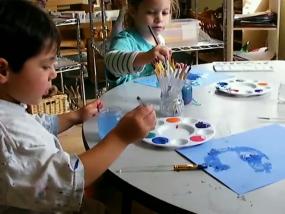Transforming Colors in Water

The boy in this video touches his brush in the red pigment, then the blue and notices how the water darkens. After touching his brush into blue again, he paints, perhaps expecting the color to be blue. But as you can see in the video, the red on his brush mixes with the blue to make a purple patch of color on the paper. The boy swirls his brush in his water, perhaps to clean it, perhaps to watch the color change. But as he swirls his brush, he looks over to his friend’s work and misses the accelerated change of the water’s color from blue to purple. When he looks down at his water, he does a double take, and exclaims, ”Hey, I turned mine purple!”
He says, “Purple” but probably does not view the new color as slightly red and slightly blue. A teacher might play next to him at another time and create more gradual transformations, beginning with mostly red but a little blue, or come in from the other direction, mostly blue but a little red. The objective here can be to help the child understand “purple” as a transformation from less red to more blue as well as from less blue to more red. According to Piaget, it is important for children to understand change as having values along a continuum and not simple discrete differences. And it is particularly important for a child to know how to reverse a transformation. See Forman and Hill, Constructive Play.
Eventually the jar has so many colors that it turns a dirty black. The child exclaims, “I turned mine black.” But the transformation occurred by such incidental additions of color that not much could be learned here other than “the water was clear before, but now it is black as the result of my putting in my paint brush.” Perhaps we can think of ways to make color transformations more “revisitable” by slowing them down or by reflecting on small additions in a series of additions. The purpose does not have to be about making marks with paint.
Keywords: Fours, Paint
Length of stand-alone master video clip: 1 minute 27 seconds
